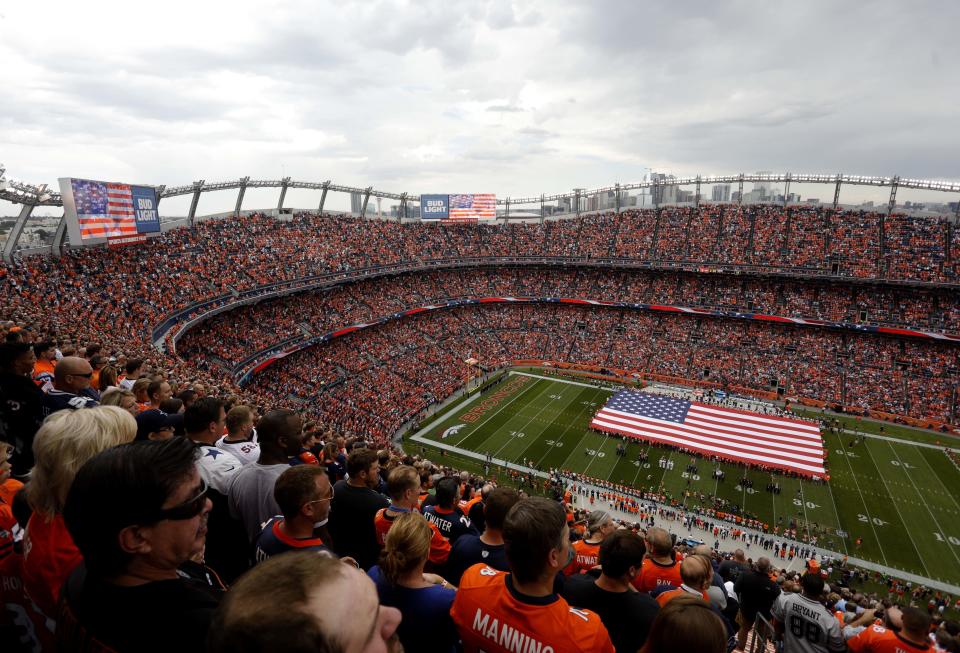NFL television ratings: No one is winning argument over what's going on with viewership
The quarterbacks are bad. Or the offensive lines are the problem.
Player protests are driving away viewers. Or Colin Kaepernick’s absence is sending them away.
Perhaps it’s the hurricanes.
The product is worse. But the Super Bowl was better than ever.
If you have a strong NFL viewership opinion, wait a day. It will shift, or someone will tell you how wrong you are. This is the NFL’s most consistent theme in 2017: everything is an eye-gouging argument over why the audience is changing. And the ratings, well, that’s the seesaw the league will be forced to ride all season long.
Through two weeks, nothing is certain and nobody is sure what is causing numbers to land where they are. And through two weeks there has been a perpetual argument over why the TV results are up and down. The most dominant questions: Why is the league’s growth and saturation slowing, who or what is to blame, and how will it be fixed?

It’s why people can’t talk about Kaepernick or player activism without weaving in a ratings conversation. It’s why domestic violence and league discipline can’t be dissected without considering how it impacts image and viewership. And it’s most definitely why the NFL and NFLPA will continue to brutalize each other for the next four years, running up a scoreboard of who is to blame for what problem, and how that is negatively impacting the overall product the two sides produce in unison.
As for the numbers, here’s where we’re at: Week 1 was uneven but mostly bad for the league, essentially down across the board, including the three critical prime-time slots: the Thursday night opener (Kansas City vs. New England) and both Monday prime-time games (New Orleans vs. Minnesota and Los Angeles Chargers vs. Denver). Only the first Sunday night game (New York Giants vs. Dallas Cowboys) of the season floated optimism, with a rise of around 5 percent over the same slot in 2016.
Initial Week 2 readings had scattered results, with Monday night (Detroit vs. Giants) yet to be played. Fox is reporting an 18 percent viewership jump week over week, propelled by the lightning-delayed game between the Denver Broncos and Cowboys, a contest that drew an initial 16.1 rating. Meanwhile, CBS was down slightly week over week, along with NBC’s Sunday night game between the Atlanta Falcons and Green Bay Packers.
[Watch on Yahoo: Ravens vs. Jaguars live from London Sept. 24]
The state of Florida remains unaccounted for in the TV ratings, due to potentially skewed numbers after Hurricane Irma.
“Sunday was a bit of a mixed bag,” league spokesman Joe Lockhart said. “You had the Fox national game that had a huge audience, particularly given that there was a weather delay that lasted for about an hour in the middle of it. I think some of the numbers were down at the [1 p.m.] game and down a little bit on the Sunday night [game]. These are the preliminary numbers. We’re going to wait and see what we get for the week when we get the final numbers. But, again, we try not to take too much out of any one week. We’ll look at this as far as the season and we’re confident that the ratings will be strong.”
The key word there is “strong.” Like last season, the numbers can fall back for the NFL this year and still be unquestionably strong. But strong doesn’t necessarily mean “up.” While the league can be confident that it will continue to do big numbers, it can’t be certain that it will continue to grow an audience that may be maxing out and flattening.
The truth here is that the NFL doesn’t know. The league’s critics don’t know. And most certainly, the heads of the broadcasting companies who paid tens of billions of dollars for the TV rights don’t know, either. That’s why this has become an annual top-of-the-agenda item for the NFL, because it is the best indicator of where the bottom line is going.
As much publicity as the league gets scouring for new markets and revenue streams, the driving force behind the money will always be television numbers. And the TV numbers will always be the best indication of the game’s saturation. Attendance numbers aside, the league needs to continue growing fan consumption at home.

This is a large reason why the NFL’s biggest move in China to date has been cutting a streaming rights deal with the country’s massive multimedia conglomerate Tencent. The NFL knows that the only way to spread football is to stimulate interest. And the only thing better than having a grassroots system of football in high school and college is to deliver the NFL product into homes at every possible turn.
The only thing more important to the NFL than the football product itself is the ratings and delivery systems. And if the ratings are down or the delivery systems aren’t growing and thriving, it means something is wrong. Either the product is off, the delivery mediums are failing, or the audience has started to reach capacity.
That’s where this argument is going. And it will sustain itself as long as the NFL can’t put out weekly news releases about how the ratings are exploding and delivery platforms are devouring all competitors. Until the audience begins to grow again consistently year over year, this is the lens that almost every debate in the NFL will be seen through.
This is all part of the perpetual seesawing argument that hangs overhead. Last week, this week and every week going forward. The NFL’s ratings are a growing mixed bag. Maybe the only lasting certainty is where the trend is headed next.
Into an argument.
More from Yahoo Sports:
• Boxing judge punished for controversial scorecard
• Coach proposes dangerous fight for Ronda Rousey
• NFL Power Rankings: Rookie changes Chiefs’ outlook

